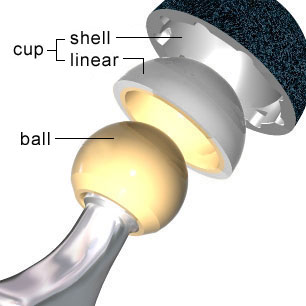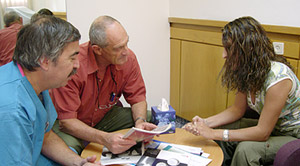Hip replacement implant
 Prosthesis is considered to be the artificial joint (sometimes referred to as “bushing”). Modern technology allows the back to an active life. Prosthesis is constructed similar to the natural joint: From (Ball) and acetabulum (socket) – the ball slipped into the acetabulum freely, similar to smooth healthy cartilage. After a detailed investigation of each case, we choose the most appropriate prosthesis from a variety of technological options.
Prosthesis is considered to be the artificial joint (sometimes referred to as “bushing”). Modern technology allows the back to an active life. Prosthesis is constructed similar to the natural joint: From (Ball) and acetabulum (socket) – the ball slipped into the acetabulum freely, similar to smooth healthy cartilage. After a detailed investigation of each case, we choose the most appropriate prosthesis from a variety of technological options.
When there is a need for hip replacement surgery?
 Surgery can be done only when quality of life is damaged and when functioning is shrinking. The decision whether to make a surgery or not is jointly patient and the surgeon after a detailed discussion of the expected accomplishments and dangers. As long as there is no such a decision, conservative treatment should be continued: A lot of joint movements, as it could be done by swimming, sitting or lying down exercises. Using crutches might be helpful. Also, anti-inflammatory medication can help, with considering side effects.
Surgery can be done only when quality of life is damaged and when functioning is shrinking. The decision whether to make a surgery or not is jointly patient and the surgeon after a detailed discussion of the expected accomplishments and dangers. As long as there is no such a decision, conservative treatment should be continued: A lot of joint movements, as it could be done by swimming, sitting or lying down exercises. Using crutches might be helpful. Also, anti-inflammatory medication can help, with considering side effects.
Before orthopedic surgeon recommends surgery, he performs a comprehensive clarification and only then comes the final diagnosis. Clarification includes physical examination, x-rays (also sometimes CT), electro-Kardiogram and general blood tests that check the functioning of all systems of the body with chest X-ray.
The surgeon will ask about any past surgeries and diseases and will seek to know what medications a patient takes regularly, and whether any vulnerability discovered. Sometimes it will be necessary to carry out mapping and mapping for denying bone infection with puncture
of the joint.
Possible Complications
 It is important to remember that, despite the many advantages of the procedure, it is a surgical procedure and, like other surgical procedures – also accompanied by risks and complications such as fractures, infections and other discharges.
It is important to remember that, despite the many advantages of the procedure, it is a surgical procedure and, like other surgical procedures – also accompanied by risks and complications such as fractures, infections and other discharges.
Recovery from the surgery typically takes several weeks, after which you can return to full activity including exercise.
During the discussion with the surgeon, he explains the possible complications, the chance of their appearance, and how to prevent it.
Consultation Meeting
During the consultation, the patient will explain about his pain and disabilities to the orthopedic surgeon.
The orthopedist will carry out a broad and accurate physical testing, including checking the movement of the hip joint, deformity, checking lower extremities nervous system and checking pulses in the legs.
Testing will be carried out along the legs to correct the non-adjusted or maintain equal leg length during surgery. (Please note that we can reach a maximum equality of your legs length by accurately measuring at the time of surgery).
This meeting will explain to the patient about the surgery, types of implants and recovery process. Also he (the patient) will receive an explanation of complications (possible risks and the expectation of significant improvement after surgery.)
Towards the Surgery
Before Surgery , when the hospitalization should take place, the patient must undergo several tests: blood tests, nasal breeding for the purpose of denial of the presence of resistant bacteria, ECG and chest X-ray.
This clarification must be done to make sure that he is healthy and allows the expected medical procedure.
A few days before the surgery the patient comes to the meeting with the nurse and the anesthesiologist (surgery conducted under general anesthesia or regional anesthesia, half body) that describes the entire process, including the recovery.
The patient is required to be on fasting for approximately 6 hours before the surgery.
If you take aspirin, you should continue doing so, as usual. It should be added that those who take medication for diluting blood has to inform the surgeon to get detailed instructions regarding the ingestion continuation.

